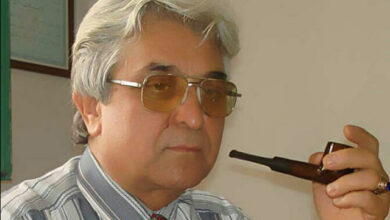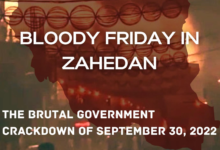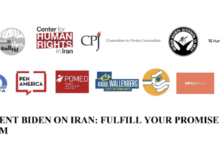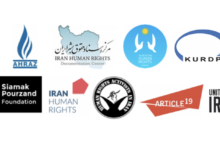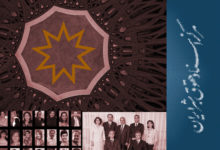The Enemy Next Door
BY ROYA HAKAKIA
In December of 1978, a chain of powerful knocks shook our courtyard door in Tehran. But the sound of the iron door rattling in its frame was not nearly as terrifying as the look on the face of the person who was rattling it. When my father finally buzzed the caller in, there was my Aunt Monavar, her face blurred behind a stream of tears. A greeting must have seemed superfluous to my father, who simply shouted: “What’s wrong, Monavar?”
She erupted. The words tumbled from her mouth. They sounded tragic, severe, frenzied, although their meaning eluded me. My father and his siblings spoke to one another in the Jewish dialect of their childhood village in central Iran, a language to which I, born and raised in Tehran, was not privy. From her heap of words, I could decipher only “fire,” over and over again. It was only when my six cousins and their father joined my aunt in our home, with all their belongings packed into a single suitcase, that I learned the deranging truth: everything had burned. The fabric store where my uncle and his brothers worked and kept all of their cash savings tucked in the folds of fabric rolls, the building that was also their home, had been reduced to ashes. An anti-Shah demonstration had turned into anti-Semitic looting, and eventually a couple of thugs had set the place on fire. Some arsons end lives. This particular one ended the history of a unique Jewish existence, richly lived, in one of the most conservative parts of Iran. Within days, my uncle, his two brothers, their wives, and their twenty-one children, with a handful of suitcases in tow, left Iran for Israel.
As readers, we are told that stories are meant to set our imagination free. But some stories are meant to burden our imagination, to obligate us, to make us think about what is inconvenient and unpopular. In my life, the story of the arson did just that. In the years after the Iranian revolution, it was often the only thing that stood between me the teenager, smitten with revolutionary ideals, and the fanatical abyss. To be an adolescent in Iran in the early 1980s and not to sign up for membership in one of the politically radical youth organizations was as strange as going to the movies and leaving after the previews. The rebellion within me had coincided with the rebellion without — an event just as rare and as dazzling as the lining up of the stars and planets. At fifteen, I was a budding writer with a small cadre of fans interested in my bromides for their various political publications. I was fervently circulating through their cliques, inhaling the smoke of their cigarettes but refusing their invitations to join. The trouble, my trouble, was that even the most enlightened intellectuals of those days, leaders who proclaimed to want to rid the world of injustice, never hesitated to demand the destruction of Israel. The question I incessantly put to myself — but dared not put to them — was: “Penniless and driven out of Iran, where would my aunt have gone?”
It would never have occurred to me to call their strange inclination “anti-Semitism,” because I had grown up in one of the most egalitarian eras in Iran’s history. My encounters with anti-Semitism were rare, by and large limited to the bitter stories that elder generations passed on to the rest of us. Then the 1979 revolution came, a moment that instilled, however transiently, a deep sense of idealism and nationalism among young Iranians of all backgrounds. One did not talk about one’s religion or ethnicity in those days. With the revolution, the nation had been reborn as one people.
Any piece of writing on Jews in Iran must acknowledge the presence of the elephant in the global room: President Mahmoud Ahmadinejad. His fiery debut has shocked the world, but every nation has its medley of radical bigots, and Iran has Ahmadinejad. While his nuclear ambitions are gravely alarming, his anti-Semitic rhetoric is designed primarily for international consumption. Within his country, his Holocaust exhibit had barely any viewers, and his Holocaust conference was a spectacle for foreigners. The locals, after twenty-seven years of being left to remain in a state of perpetual defiance, are tired of spectacles. It is the Iranian secular elite whose silence over Ahmadinejad’s Holocaust statements is disturbing, especially in light of their vociferous stance against Israel.
Unlike their Arab counterparts, Iranian intellectuals were not unanimously anti-Israel from the start. There was a moment in the early 1960s when a few of Iran’s most influential thinkers embraced the cause of Israel. A leading socialist named Khalil Maleki, through his party contacts in Europe, learned about the kibbutzim and the intentions of their European settlers to create a socialist utopia. On an invitation from the foreign ministry, Maleki took a trip to Israel. He returned with such positive impressions that the ministry extended the invitation to several others. Of these, Abolhassan Banisadr, now exiled in Paris, became Iran’s first president. Another of the travelers was the writer Jalal al-Ahmad, whose seminal book on the corrupting effect of the West on Iranian culture, called Westoxification, became the bulwark that united the anti-Shah elements on both the religious and secular sides. Yet another was Daryoush Ashouri, a protégé of Maleki’s and a formidable social critic and philologist with major contributions to the Persian lexicon.
With the exception of former president Banisadr, who was unmoved by the experience, these celebrated pilgrims were all smitten by Israel — by the intelligence of the new settlers, and most of all by the austerity of their lifestyle. Maleki, al-Ahmad, and Ashouri published their highly sympathetic travelogues in the leading literary journals of the time. They were authorities in their era, and theirs remained the final word on Israel for several years. But the word, however favorable, was not a genuine reflection of Jews, or of the Jewish state. Their love affair with Israel was merely an extension of their love affair with socialism.
In 1967, after Israel’s victory in the Six-Day War, the tide began to turn, although, even then, the undaunted Ashouri published another article defending Israel, accusing those who were categorically supporting the Arab cause of anti-Semitism and of betraying their status as progressives. (As far as his career is concerned, Ashouri calls this article the costliest writing of his life. Forty years later, he continues to be called a Mossad agent, a slander that drove him out of Iran for the second time in the late 1990s.)
There was, indeed, an underlying anti-Semitism at work even among the most enlightened Iranians, although I had hardly encountered it while in Iran. They had all heard of, if not been personally terrorized by, the urban legend that an essential ingredient for the Passover matzah was the blood of young Muslim children — a tale that kept many terrified non-Jewish children from passing through Jewish neighborhoods in the dark. But it was after 1967 that secular elite opinion turned against Israel, and not so much as a result of pan-Islamism. It happened when Israel was reinvented as the third party in an evil political trinity: Israel equaled America, and America equaled the Shah. This was a wholesale formula. One struggled against all three or against none at all.
The story of the fire burdened my imagination back in Iran when Israel was under indiscriminate attack, and it does so again today when Iran is portrayed as pariah.
Looking at the history of Jewish immigration since 1979, it is clear that the arson my aunt and her family suffered was an exception, not the rule, in the postrevolutionary era. The majority of Iranian Jews who have left Iran since 1979 have left because of the regime’s virulent rhetoric, not because of the violent acts of their friends and neighbors. In a theocracy where opportunities were granted not according to merit but to “mullahiximity” — proximity to a mullah by blood or other ties — the possibilities of prosperity began to diminish quickly for Jews, as they did for non-Jews with no connection to the new ruling elite.
But the spirit of the early 1960s may be making a discreet comeback. The Iranian exile community has embraced Israel. Some leading opposition members, inside and outside of the country, have taken the position that as a non-Arab nation, Iran’s national interest is better served by normalizing relations with Israel. Several young Iranian opinion makers have dared to travel to Israel. Despite the penalties associated with such an adventure under the current regime, one among the new generation, Hossein Derakhshan, a high-profile blogger and writer, wrote favorably of his visit and has since returned to Israel for a sequel
As before, behind this generation’s sudden softening toward the Jewish state lie other motives, which have to do with their desire to ally themselves with the enemy of the enemy — the latter being the regime in Tehran. As the public turns more and more against the regime, they grow more suspicious of its propaganda and weary of its costly ideological stances. With unemployment rates skyrocketing inside the country while desperately needed funds are directed to Hezbollah and Hamas, the Palestinian cause is losing popularity among Iranians. Palestinians in Iraq have already been through such a reversal of fortunes: under Saddam Hussein, they were lavishly treated, which is why they are now the objects of public vengeance.
How Jews assess and understand today’s Iran is critically important. To see Iran as a threat through and through is to buy into the Iranian regime’s propaganda. Beyond the dangerous anomaly of Ahmadinejad, there is a greater picture, of a country unlike all the rest in the region, where a curiosity for Israel is beginning to grow — a country where Jews found a safe haven nearly 3,000 years ago, where the most sacred sites of their history outside of Israel remain, where fleeing Polish Jews discovered a reprieve from the Nazi atrocities in the early 1940s, where Jewish life has been (however bitterly at times) tolerated, and which, despite nearly thirty years of a fundamentalist order, is still home to the largest community of Jews in the Middle East outside of Israel. No, Iranians are not free of anti-Semitism, but there is bigotry and there is bigotry: the kind that has spurred the Kristallnachts of Jewish history, and the kind that comes from ignorance. Contemporary Iran falls mostly into the latter category.
The test of the integrity of the Iranian Jewish community will be the way in which it chooses to tell the tale of its days in Iran and commit that history to record. But in this act there are far greater implications. The generation that was born and raised in Iran, despite all hardships, can be a bridge to a different kind of peace — not one between the Israelis and the Palestinians, but one that transcends two damaging myths: first, the myth that to be Iranian is to hate Israel or the Jews, and second, the myth that insists on the falsehood that to be united as Jews we must compromise the complexities of our individual histories and adhere to a single narrative.
If truth ever could, this is the kind that shall set us free.
http://www.guiltandpleasure.com/index.php?site=rebootgp&page=gp_article&id=45




